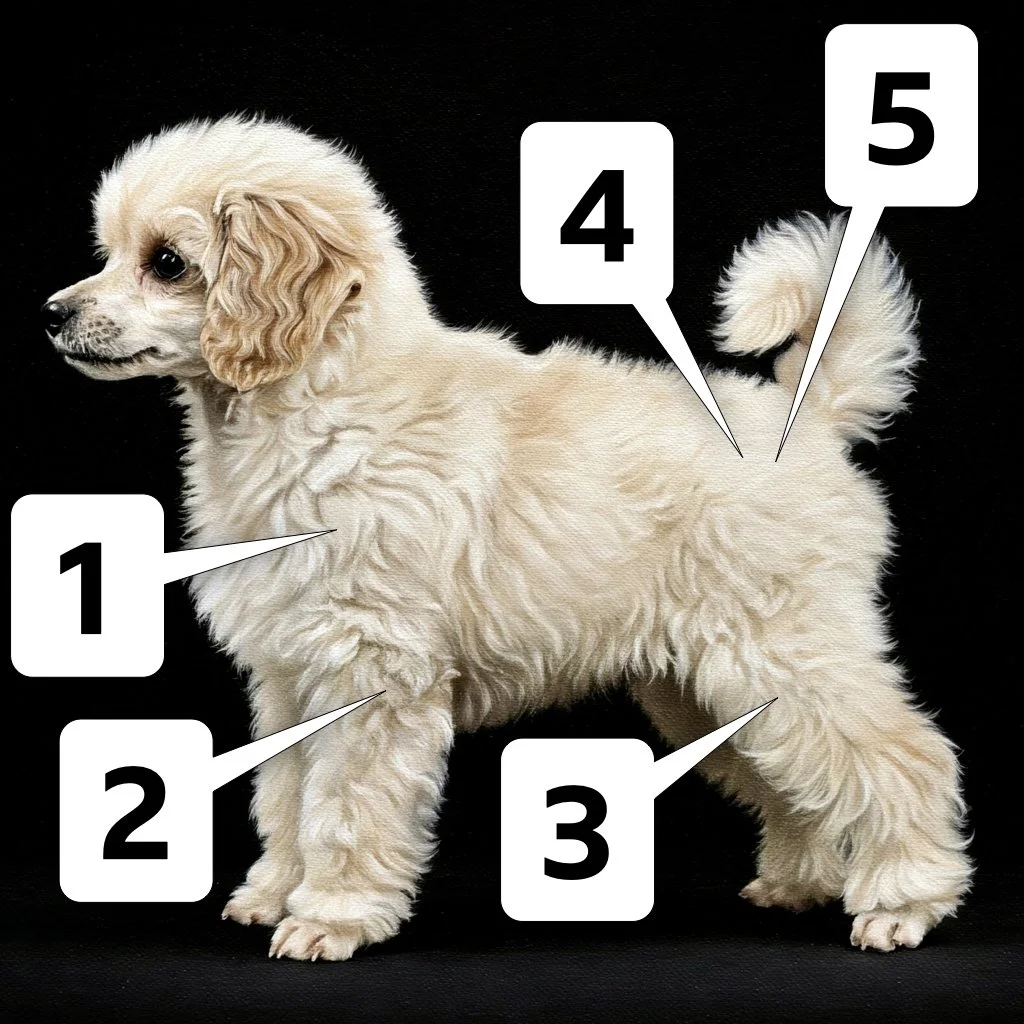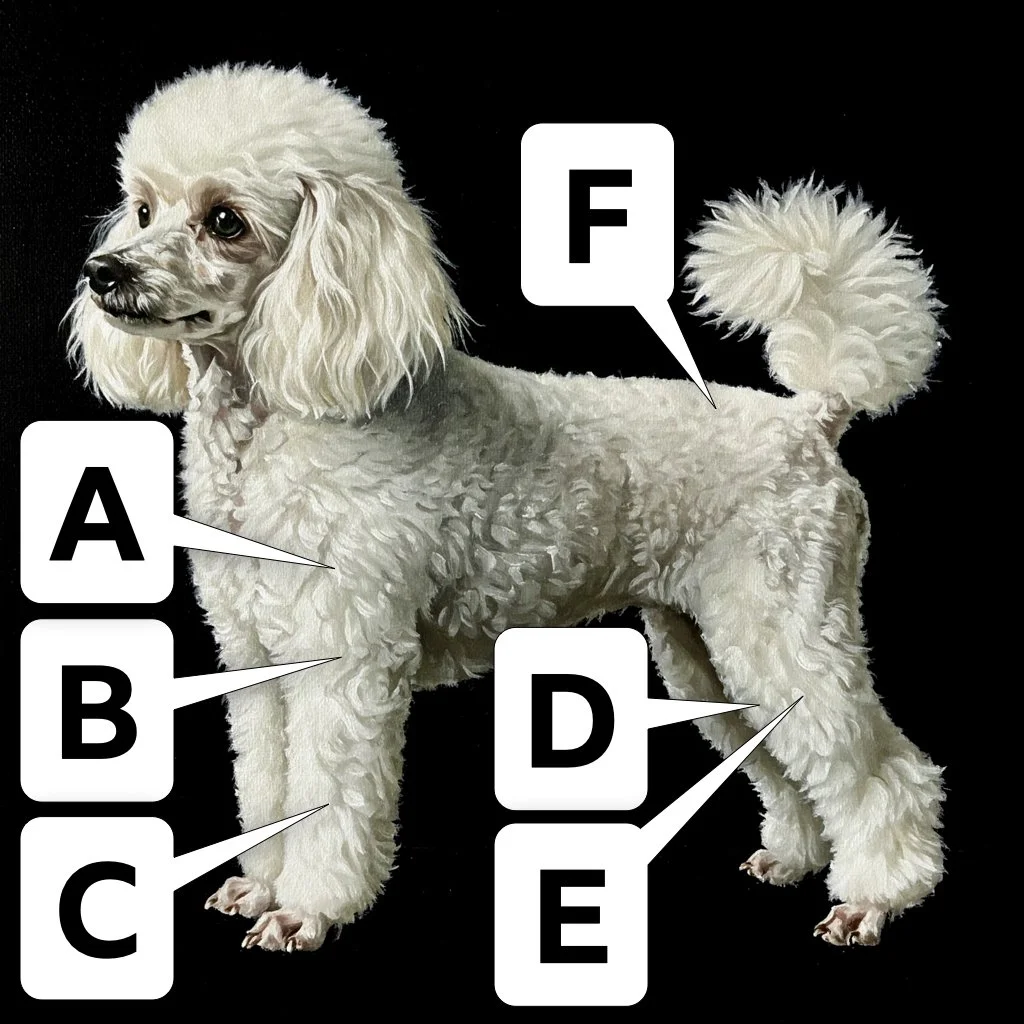TOY POODLE
TOY POODLE
Lameness in Puppies
-
Problem: All dogs have shallow shoulder joints, but the articulation is particularly shallow in toy breeds. This provides less inherent stability and places excess stress on the rotator cuff muscles. In some dogs, shoulder malformation is extreme, resulting in a deformed (dysplastic) shoulder joint. Repetitive strain of the rotator cuff muscles can be painful.
Diagnosis: X-rays or a CT scan and manipulative tests.
Treatment: Typically begins with non-surgical approaches, including physical therapy, weight management, and anti-inflammatory painkillers. For the minority of dogs who don't respond well, surgical arthrodesis (joint fusion) is a viable option. Despite being a major procedure, arthrodesis is known to significantly improve comfort and mobility.
-
Problem: Only 3% of Toy Poodle x-rays submitted to the Orthopedic Foundation for Animals (OFA) show this condition.
Diagnosis: A CT san may be necessary because x-rays often miss subtle elbow dysplasia.
Treatment: Elbow dysplasia has no ‘cure’, and a single universally effective treatment doesn't exist. Dysplasia always leads to secondary arthritis, and arthritis severity is proportional to the severity of dysplasia. In puppies, the primary goal is to limit the progression of joint deformity during growth. While medical interventions (e.g. supplements) cannot alter bone or joint development, surgical options exist which can be highly effective. Learn more…
-
Problem: Patella is the Latin term for kneecap, and luxation means dislocation. Therefore, patellar luxation refers to the complete dislocation of the kneecap, while subluxation indicates imperfect tracking. The most frequent sign is limping, which can be either intermittent or persistent. Lameness arises from impaired joint mechanics, pain, or a combination of both. Many affected dogs skip for short periods, then spontaneously resume normal movement. In these dogs, the lameness is likely (though not definitively) due to abnormal joint mechanics. To discern if pain is a contributing factor, watch out for signs of chronic pain, such as consistent or frequent lameness and diminished exercise tolerance. These indicators could suggest a debilitating condition comparable to patellofemoral pain syndrome in humans.
Diagnosis: Diagnosis is made using a physical exam. X-rays are only necessary to rule-out other conditions and/or when surgical treatment is being considered.
Treatment: The earlier the onset of luxation, the more pronounced the resultant deformities. Bowing and twisting of the femur (thigh bone) and tibia (shin bone) significantly disrupt knee joint mechanics. Critically, normal patellar groove development relies on central patellar tracking. Early luxation precipitates patellar groove dysplasia, often resulting in a flattened or convex surface. Prompt surgical intervention in growing puppies can mitigate or reverse so-called ‘miserable malalignment’ and groove dysplasia. In children, where recurrent patellar dislocation is associated with less severe deformities, surgical management is also the gold standard. Learn more…
-
Problem: Legg-Calvé-Perthes disease (LCPD) is a genetic condition where the femoral head's blood supply is compromised, leading to bone weakening, collapse, and secondary arthritis. It is thought the be a manifestation of osteochondrosis, a condition with a significantly lower risk in lean puppies eating a balanced diet without calcium supplementation.
Diagnosis: Early diagnosis is crucial for optimal outcomes; therefore, x-rays or the more sensitive CT scan are strongly advised if LCPD is suspected.
Treatment: While two studies published in the 1960’s claim an 18-24% success with non-surgical treatment, current best practice favours early intervention, either with bone marrow injections into the femoral neck, femoral head excision, or total hip replacement.
-
Problem: Orthopedic Foundation for Animals (OFA) data reveals that 23% of submitted hip x-rays show dysplasia, and another 15% indicate fair hip quality.
Diagnosis: If your Toy Poodle shows signs of hip pain, prompt x-rays are highly recommended. This is crucial to screen for Legg-Calvé-Perthes disease, a condition common in this breed (see above).
Treatment: It's vital to differentiate between Toy Poodles with x-ray evidence of hip dysplasia but no pain, and those with both x-ray findings and pain. One study tracked 29,000 dogs from breeds known for a high risk of hip dysplasia: Bernese Mountain Dogs, German Shepherds, Golden Retrievers, Labradors, and Rottweilers. All dogs underwent hip x-ray screening at 1-year-old and had lifetime insurance coverage. Claim rates for hip dysplasia were 1.5% for mild cases, 5% for moderate cases, and 15% for severe cases. This means that, in this study, at least 85% of dogs showing incidental hip dysplasia on x-rays did not develop clinical signs severe enough to warrant an insurance claim. Learn more…
Lameness in Adults
-
Problem: Shoulder dislocation (luxation) can occur with or without trauma in toy dogs with pre-existing shoulder dysplasia (see above). The inherently unstable joint is prone to injury of the supporting muscle and ligament cuff. This manifests as shoulder instability and/or luxation. One study found that 17/18 affected dogs were Toy Poodles with an average age of 10 years.
Diagnosis: X-rays or CT and manipulative tests.
Treatment: While a dislocated shoulder can be manually reduced, recurrence is common in dogs with dysplasia. A specialised harness may provide effective support in some cases. Surgical options, such as prosthetic ligament insertion or joint fusion (arthrodesis), may be necessary for persistent instability and/or recurrent luxation.
-
Problem: Elbow arthritis is uncommon in adult Toy Poodles, primarily because the most frequent cause, elbow dysplasia, rarely occurs in this breed.
Diagnosis: A CT scan may be needed, as X-rays can miss subtle signs of elbow dysplasia. Joint fluid analysis is often recommended in older dogs to exclude immune-mediated polyarthritis (IMPA - see ‘erosive arthritis’ below).
Treatment: While elbow arthritis cannot be cured, various effective non-surgical management strategies are available. Learn more…
-
Problem: Older Toy Poodles can develop erosive (rheumatoid) arthritis (RA), an immune-mediated polyarthritis (IMPA) that mirrors human RA. Affected dogs suffer progressive joint destruction, particularly in the lower limbs, with the carpi (wrists) and digits being most commonly affected.
Diagnosis: There is a high suspicion in older dogs with collapse of one or more joints, especially the carpi. Diagnosis is confirmed with a combination of x-rays and joint fluid analysis.
Treatment: Similar to human RA, canine erosive arthritis is typically managed with immunosuppressive medications. In some cases, arthrodesis (joint fusion) may be necessary to alleviate pain.
-
Problem: There are 4 grades of patellar luxation: (GRADE 0) Normal kneecap tracking. (GRADE 1) The kneecap can be manually dislocated but returns to its normal position; dogs are typically not lame. (GRADE 2) The kneecap dislocates spontaneously during knee movement and can be repositioned. (GRADE 3) The kneecap is permanently dislocated but can be manually repositioned, though it dislocates again when pressure is released; severe bone deformities are common. (GRADE 4) The kneecap is permanently dislocated and cannot be manually repositioned. Learn more…
Diagnosis: Diagnosis is made using a physical exam. X-rays are only necessary to rule-out other conditions and/or when surgical treatment is being considered.
Treatment: Surgery is recommended for adult dogs who limp frequently or constantly. Learn more…
-
Problem: Anterior cruciate ligament (ACL) tears are a frequent cause of intermittent or persistent hind limb lameness in Toy Poodles. Partial tears may cause occasional stiffness and lameness after activity, while complete ruptures result in obvious, persistent lameness.
Diagnosis: Diagnosis is made using a physical exam. X-rays are only necessary to rule-out other conditions and/or when surgical treatment is being considered.
Treatment: Multiple studies show faster and more complete recovery, as well as a longer lifespan, in dogs that undergo surgery. Surgical options are available for dogs with concurrent patellar luxation and ACL rupture. Learn more…
-
Problem: Intervertebral disc disease (IVDD) occurs when one or more intervertebral discs herniate, compressing the spinal cord or peripheral nerves that supply the legs. This causes varying degrees of weakness and pain, depending on the affected disc’s location, the herniation’s suddenness, and the severity of nerve compression. Lumbosacral disc bulging, similar to sciatica in humans, typically causes intermittent lameness and pain.
Diagnosis: Early diagnosis is essential for the best outcomes; therefore, a CT or MRI scan is recommended.
Treatment: There is no single ideal treatment for IVDD. Options depend on the herniation’s location, the degree of nerve compression, and the severity of clinical signs.










